Baseball Pitching Drills
I find Baseball Pitching Drills, are often either overlooked or totally forgotten by some coaches. Granted most everything written about teaching the position pertains to mechanics, different grips, control, speed …you get the idea. But sometimes we forget, the Pitcher is also an infielder responsible for fielding his position.
The drills below with have your Hurler automatically react to four of the most common fielding responsibilities of His position.
Covering First Base: and Baseball Pitching Drills
When a ball is hit to the right side of the infield the pitcher should automatically, without hesitation, start running towards first base assuming he'll have to receive a throw from the infielder for the put out.
I say again .... this should be Automatic.
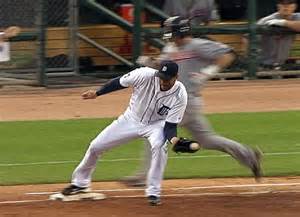
There is One Method for covering the base with a slight variance in foot work by the pitcher.
The First Method is for the pitcher to take a Direct Line from the mound to First Base, glove up giving the fielder, usually the first baseman, a target to throw at.
After catching the ball tag the base with your right foot on the infield side of the base, being careful not to step on flat part of the base, which helps avoid getting spiked by the runner if the play is close.
The second method is for the pitcher to run directly to a point of the foul line @ 5' to 6' in front of the base and run straight up the inside of the foul line to the base, again giving his glove as a target and stepping on the inside of the base.
I've found this approach to work better at younger ages, because it's easier for the infielder to lead the pitcher coming at him face first.
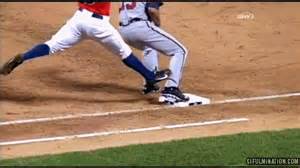
Never Step On The Base
Come Backer to the Mound and Baseball Pitching Drills
As with many things in baseball, this task is not as easy as it first appears. The pitcher, first and foremost, is concerned about throwing his pitch, which tends to totally consume some pitchers.
He must already know the situation, the way he pitches depends on it, plus he’s no different than any other fielder and must know how many outs there are, how many base runners, if any and what bases they’re on, but these facts seem to allude some pitchers.
By pre-programming himself as to what he’ll do with ball in the event of a Come Backer, he immediately turns and throws to the base, with no hesitation in getting the lead runner at second or third base.
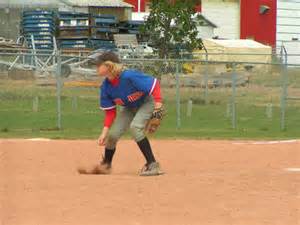
Should the bases be empty, wait for the first baseman to reach the base, step and throw. Do not lob or soft toss the ball, throw it, as soft throws result in many more miscues than a good strong throw to first.
Covering Home Plate and Baseball Pitching Drills
With a runner on third base, if you throw a pitch in the dirt, immediately run to home plate. Don’t look to see if the runner is trying to score, Don’t wait to see if the catcher blocked the ball, assume he is running and the catcher didn’t block the ball.
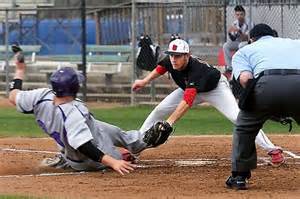
Applying the Tag
Backing Up Bases Baseball Pitching Drills
1. With a runner on first base and a hit to the outfield, the pitcher should automatically go to third base to back up in the event of an overthrow or an off line throw.
He should position himself distance 10 - 15 feet behind the third baseman, if you’re too close and the 3rd baseman is unable to catch the ball, you won’t be able to either.
He should be facing the direction the throw will be coming from, in other words face the outfielder who’s throwing the ball.
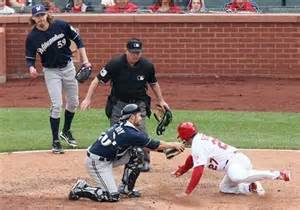
Backing Up Home Plate
With no runners on and a hit to the outfield the pitcher should back up second base. If the ball is hit to right field, the second baseman will go out to become the relay man, shortstop will cover second base. You’ll back up the shortstop.
Hit to left field the shortstop will be the relay man, the second baseman covers the base. You back up the second baseman.
Hit to center field, depends on who, shortstop or second baseman, goes to be the relay man.
One more normal situation - Baseball Pitching Drills
A runner on second and a hit to the outfield, whether it‘s a fly ball, which drops or a ground ball, the pitcher should back up the catcher at home plate in the event of an off line or overthrow from the outfielder or relay man.
A good time to practice these drills is when you’re hitting outfield practice and having the fielders throw to a particular base.
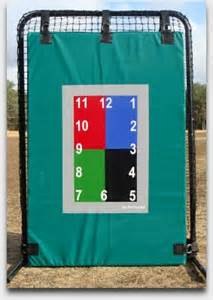
Pitching Drills are a fact of life if you want to become a good pitcher, so let’s look at a few drills which will enhance our physical and mental game.
Tarp Drill: --- Baseball Pitching Drills
This drill is relatively inexpensive to equip and allows more than one pitcher at a time to throw without tying up a catcher.
1. Buy a 10’ X 10’ colored plastic tarp and cut it into 4 - 5’ X 5’ pieces.
2. Paint or tape a rectangular strike zone on each and hang the tarp securely.
3. If you have them, place a rubber home plate in align with the strike zone.
4. Beginning at ¾ pitching distance have the pitchers throw 20 balls each. Ten from the windup - ten from the stretch.
5. Move back to regulation pitching distance and repeat.
As the pitchers’ accuracy increases, cut the strike zone into halves, then quarters and have them focus on hitting certain parts of the strike zone.
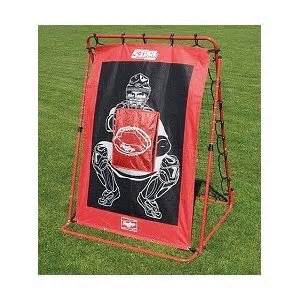
Store Bought Target
Control Pitching Drills: --- Baseball Pitching Drills
No different than a batter afraid of being hit by a pitch, sometimes a pitcher can be afraid of hitting a batter.
If you have a pitcher with good control and velocity when throwing to the catcher without a batter, but begins aiming the ball when a batter steps in the box, it’s a sure indicator he’s afraid of hitting the batter. It may be a subconscious fear and he isn’t even aware of it.
Have the pitcher throw 10 - 15 pitches to the catcher, zeroing in his control and speed. Once you’re comfortable with his control have a batter move into the batters box wearing a helmet, but no bat. Have the pitcher begin throwing again.
If his control or velocity is suddenly noticeably different now there is a batter, stop the drill. Go to the mound and talk to the pitcher. Explain why the drill and the reason the hitter doesn’t have a bat is because he’s there to give the game like feeling of a batter, but is solely concentrating on getting out of the way of a wild pitch.
Baseball Pitching Drills To Learn to Pitch

New! Comments
Have your say about what you just read! Leave me a comment in the box below.